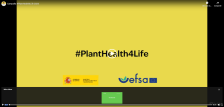Media library
Documentary, graphic and/or audiovisual knowledge objects are offered here, offering information on various sectors and topics. Use the keyword search or search filters to access current audiovisual and documentary knowledge objects useful for your implementation.
If you have any questions or suggestions, please contact us here.
Information note and management recommendations: thrips damage to citrus, persimmon, and pomegranate.
Given the damage caused by thrips observed since May on leaves and fruit in various citrus, persimmon and pomegranate crops and the confirmation of the presence of Scirtothrips aurantii Faure in certain areas, the following recommendations have been considered appropriate:
Recommendations for the strategy to control leaf necrosis in persimmons
During the 2019 campaign, control failures were detected in some plots in the Ribera Alta region (Alzira, Benimuslem, Guadassuar, and Massalavés). Systematic surveys carried out in 2020 revealed that the resistance of the fungus Plurivorosphaerella nawae to the QoI group of fungicides (strobilurins) was present in most persimmon-producing areas in the province of Valencia.
Scirtothrips aurantii, information note and management recommendations, damage caused by thrips in citrus, persimmon and pomegranate.
Given the damage caused by thrips observed since May on leaves and fruit in various citrus, persimmon and pomegranate crops and the confirmation of the presence of Scirtothrips aurantii Faure in certain areas, the following recommendations have been considered appropriate:
Triptych Rhynchophorus ferrugineus (Red palm weevil)
Recommendations for treatments against red palm weevil and other palm borer pests
Paysandisia archon Triptych, recommendations against the palm borer caterpillar
Paysandisia archon, a lepidopteran of the Castniidae family, is native to South America, whose larvae feed on palm trees. The first detection in Europe was in France and Italy in 1998-99. In Spain, it was first detected in Catalonia in May 2002, and in the Valencian Community in June of that same year.
Monitoring Scirtothrips aurantii on citrus, pomegranate and persimmon.
Scirtothrips aurantii is a pest that affects various crops such as pomegranates, persimmons, citrus fruits, and table grapes. This pest was first detected in Spain in 2020, in the province of Huelva.
Monitoring Pseudococcus longispinus in Persimmon
Cottony mildew is one of the pests that most concerns the persimmon production sector in the Valencian Community. They feed on the plant's sap, weakening it, and excrete large amounts of honeydew, on which saprophytic fungi develop, forming a characteristic black felt known as "sour patch." Fruits stained with sooty mold lose commercial quality.
Monitoring Paraleyrodes minei in Persimmon
Whiteflies are among the pests of greatest concern to the persimmon production sector in the Valencian Community. Within this group of insects, the species most commonly found on persimmons are Dialeurodes citri, Paraleyrodes minei, and Aleurothrixus floccosus.
Monitoring of Dialeurodes citri in persimmon and citrus fruits.
Whiteflies are the pests that have most concerned both the persimmon and citrus production sectors in the Valencian Community in recent years. Within this group of insects, the species most commonly found are Dialeurodes citri, Paraleyrodes minei, and Aleurothrixus floccosus.
Thaumatotibia leucotreta (Meyrik) Contingency Plan
This document sets out the measures to be adopted against Thaumatotibia leucotreta (codling moth), a pest regulated by the EU as a priority quarantine pest under Implementing Regulation (EU) 2019/2072 and Delegated Regulation (EU) 2019/170.
Persimmon leaf spot
Fact sheet for the control of Mycosphaerella nawae in persimmon.
Citrus whitefly, Dialeurodes citri Ashmead, in persimmon crops in the Rivera region.
Persimmon cultivation is expanding and widespread in the Valencian Community, especially in the La Ribera region. The increase in cultivated area and its coexistence with other traditional crops in the area are leading to the establishment of various pests in the persimmon.
Recommended chemical control strategy for persimmon plots with Scirtothrips problems
Period from bud break to flowering: The presence of Scirtothrips will be assessed weekly using two main methods: 1. Captures in yellow chromatic traps as an indicator of early presence. These traps require inspection by specialized technical personnel. 2.
Self-explanatory talk Rhynchophorus ferrugineus (Red Palm Weevil)
Information talk on Rhynchophorus ferrugineus. Directorate General of Agrifood Research and Technology
Notice of treatment against persimmon leaf necrosis
Fungicide treatments should be scheduled to cover the INFECTION RISK PERIOD, which is defined by the availability of Plurivorosphaerella nawae inoculum, the phenology of the persimmon, and climatic conditions.
National Contingency Plan for Eotetranychus lewisi
This document sets out the measures to be taken against Eotetranychus lewisi, a regulated harmful organism, with the aim of preventing its emergence and, if it does, acting quickly and effectively, determining its distribution and implementing eradication measures. Eotetranychus lewisi is a mite of the Tetranychidae family.
National Contingency Plan for Fusarium oxysporum f. sp. Cubense (EF Sm.) WC Snyder & HN Hansen Tropical Race 4
This document sets out the measures to be taken against Fusarium oxysporum f. sp. cubense Tropical Race 4 (Foc RT4), a quarantine pest in the Canary Islands regulated by the Ministerial Order of 12 March 19871 with the aim of preventing its appearance on the islands and, if it does, acting quickly and effectively, determining its distribution and implementing eradication measures.




